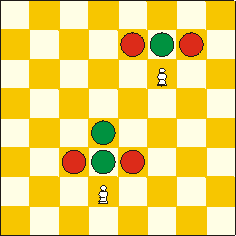Pawn
Historic remarks
With slightly different movement rules, the Pawn is the same as it was in Chaturanga, the earliest known form of Chess, about one-and-a-half millenia ago in India.
At the period in the history of Europe that marked the end of the Middle Ages and the start of the Renaissance, movement of the Pawn was slightly changed: it gained its initial double step, and later en-passant capture, and different promotion rules were added.
More than any other piece, the Pawn is the chess piece that is used as a metaphor: phrases like `he was just a pawn in a chessgame' signify someone whose personal interests are sacrificed by others in a pursuit of other goals, referring to the pawns role in a chessgame.
The Pawn was originally called a padati, which was Sanskrit for foot-soldier. The Persians translated this to piyada, the Persian word for foot-soldier. The Arabs tranliterated the Persian name to baidak, which meant nothing but a Pawn in Chess. In Latin, it was pedo, pedonis,or pedes, all meaning foot-soldier. This led to the French pion, which also meant foot-soldier. And this led to the Anglo-French poun, which led to the English Pawn. Although it is etymologically related to words for foot-soldier, Pawn isn't used in that sense in English. All the English word means is the piece in Chess.
The German name is Bauer, which means peasant.
Movement rules
Paws can only move forward. When a pawn makes a non-capturing move, it goes one square forwards. When a pawn is still on its original square on the second row, it can make a non-capturing move forwards of one or of two squares - if it moves two squares, the first square must be empty. A pawn captures one square diagonally forwards.When a pawn has moved two squares forwards, the opponent has the possibility to take it en passant: in the directly following turn a pawn of the opponent may take it also on the square that was passed by.
When a pawn reaches a promotion square, that is, a square on the last row of the board at the opponents side, it promotes. The owner of the pawn may decide to which piece the pawn promotes. In standard chess, this is a queen, rook, knight, or bishop of the same color as the pawn. It is possible to promote to a piece that is not lost, so for instance, by promotion, a player could have two or more queens on the board in standard chess.
In chess variants, and fairy chess problems, the most used and recommended rule is to allow promotion to any type of non-royal piece that was on the board at the start of the game (i.e., no promotion to king, unless specified otherwise). Promotion is still to a piece of the same color.
Movement diagram
A Pawn moves without capturing by stepping straight forward one space, and it captures by moving diagonally forward one space. The most accurate adaptation of the Pawn's movement on a hexagonal board comes from McCooey's Hexagonal Chess. This is diagrammed on the right. In Glinski's Hexagonal Chess, the Pawn captures orthogonally forward on the slanting rows, and Glinski incorrectly describes this as diagonal movement.
Squares where the pawn can move to without taking are marked with a green circle; squares where the pawn can move to with taking are marked with a red circle in the left diagram, and with a red X in the right diagram.
 |
 |
For more information on how the Pawn moves in modern Chess, such as capturing by en passant, see our Illustrated rules of chess or the FIDE laws of chess.
Vocabulary: Divergent
The Pawn is a divergent piece. This means that its capturing moves and its non-capturing moves are not the same. In the Pawn's case, it captures one space diagonally forward, and it moves without capturing one space vertically forward. The Pawn is the only divergent piece is regular Chess. The other pieces capture and move in the same way. But other divergent pieces are sometimes used in other variants. A few of these divergent pieces include the Berolina Pawn, the Murray Lion, and the Cannon.
Alternate Images
Click on an image to view the full piece set it belongs to.
 |
||
References
Davidson, Henry A. A Short History of Chess, 1949.
Eales, Richard. Chess: The History of a Game, 1985.
Written by Hans Bodlaender and Fergus Duniho.
WWW page created: October 13, 1998; Last Updated: December 15, 2001.
